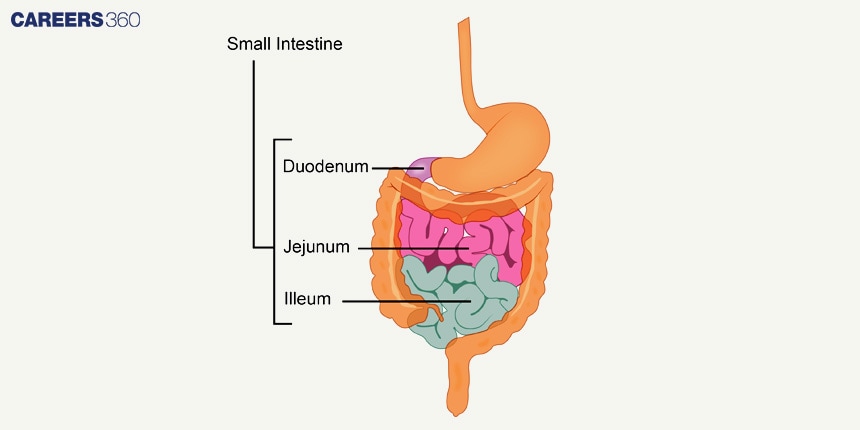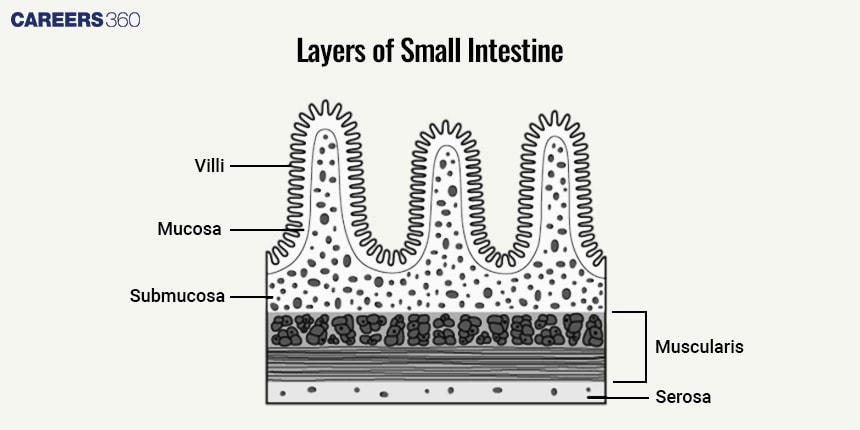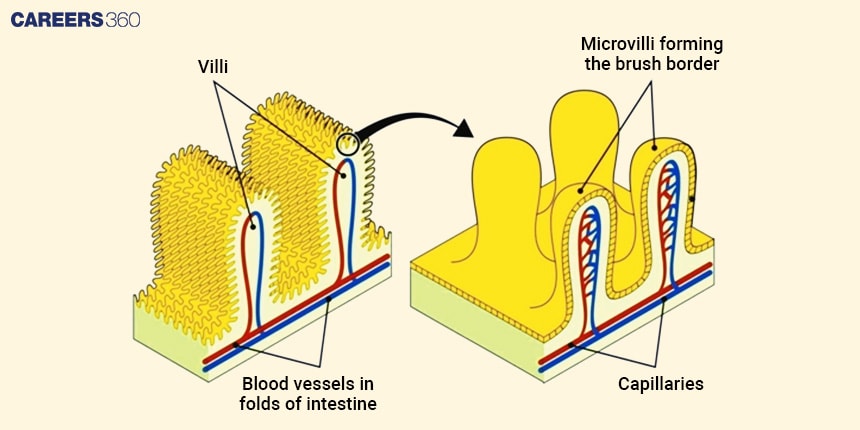Small Intestine Diagram
The small intestine diagram shows the anatomy of this important organ helping in nutrient digestion and absorption. It has three sections: duodenum, jejunum, and ileum. A diagram helps explain how enzymes break down food and how to take in nutrients into blood. This is a topic from the Class 11 chapters on Digestion and Absorption which is important for exams such as NEET and AIIMS BSc Nursing, where biology is the major subject.
NEET 2025: Mock Test Series | Syllabus | High Scoring Topics | PYQs
NEET Important PYQ's Subject wise: Physics | Chemistry | Biology
New: Meet Careers360 B.Tech/NEET Experts in your City | Book your Seat now
- Small Intestine
- Labelled Diagram of Small Intestine
- Parts of the Small Intestine
- Small Intestine Layers
- Intestinal Glands

Small Intestine
The small Intestine is the main component of the digestive system, which absorbs almost all nutrients. It has three parts: duodenum, jejunum, and ileum. The small intestine breaks down food into nutrients with the help of digestive enzymes and absorbs those nutrients into the bloodstream. Such absorption ensures that the body receives the energy and necessary nutrients, hence being highly important.
Labelled Diagram of Small Intestine
The diagram shows the parts of the small intestine:

The small intestine represents an important part of the digestive system through which food is received from the stomach and then digested and absorbed. It is a long, coiled tube that starts from the stomach, ends by the large intestine, and extends to a length of about 20 feet. Its long length and structure specialisation let it efficiently process and absorb the needed nutrition for the body's functions.
The small intestine lies in the abdominal cavity, and upon further division, it includes the duodenum, jejunum, and ileum. Various parts of each segment have different roles in digestion, breaking down food, and absorbing it into the bloodstream for utilisation.
Also Read:
- Practice MCQ on the Small Intestine and its Histology
- Digestion and Absorption
- Chemical Coordination and Integration
Parts of the Small Intestine
The small intestine is mainly divided into three parts:
Duodenum
The first part.
Here most of the chemical digestion is done.
Jejunum
The middle part.
Mainly responsible for the absorption of nutrients.
Ileum
The last part.
Responsible for absorption of vitamin B12 and salts of bile.
Small Intestine Layers
The diagram below shows the different layers of the small intestine.

The layers of the small intestine are divided into:
Mucosa
The innermost layer, lined with villi and microvilli
It can increase the surface area for absorption.
Submucosa
A supportive layer containing blood vessels, nerves and glands.
Muscularis externa
Responsible for movements of peristalsis and segmentation.
Serosa
Outermost protective layer.
Diagram of Intestinal villi

Surface Area and Villi
Villi and microvilli greatly increase surface area to promote nutrient absorption.
Blood vessels and lymphatics are found in these structures to transport the absorbed nutrients.
Intestinal Glands
Intestinal glands are located on the inner lining of the small intestine and are responsible for digestion. They secrete digestive enzymes, mucus, and hormones. These glands are composed of different cells including goblet cells that produce mucus, enterocytes which are involved in nutrient absorption, and enteroendocrine cells that release hormones to regulate digestion. The secretions help protect the intestine and ensure efficient digestive processes.
Video Recommended on Small Intestine
Also Read:
Frequently Asked Questions (FAQs)
The small intestine is divided into three parts: the duodenum, jejunum, and ileum.
The small intestines help in digestion by the activity of enzymes and bile breaking food into absorbable nutrients.
Villi are small, finger-like projections that increase the surface area for nutrient absorption in the small intestine.
Common disorders include Crohn's disease, celiac disease, and irritable bowel syndrome.
In herbivores, it takes longer to help digest fibrous plant material. In carnivores, it is shorter due to their protein-rich diet.
Also Read
30 Nov'24 03:25 PM
26 Nov'24 05:38 PM
25 Nov'24 06:43 PM
25 Nov'24 05:45 PM
25 Nov'24 04:48 PM
25 Nov'24 03:52 PM
23 Nov'24 04:30 PM
23 Nov'24 10:03 AM